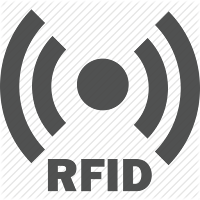"Radio Frequency Identification - RFID"
"MAIN OBJECTIVE OF THIS ARTICLE"
ü Know
what is RFID?
ü Know
the components of an RFID System
ü Applications
of RFID and implementation of RFID in respective fields
“Radio Frequency Identification” - (RFID) can
be seen as a micro-chip in a label used to transmit data when it is exposed to
radio waves. RFID use of radio waves to read and capture information stored on
a tag attached to an object. A tag can be read from up to several feet
away and does not need to be within direct line-of-sight of the reader to be
tracked.
Radio-frequency identification (RFID)
uses electromagnetic fields to automatically identify and track tags attached
to objects. The tags contain electronically-stored information. Passive tags
collect energy from a nearby RFID reader's interrogating radio waves. Active
tags have a local power source (such as a battery) and may operate hundreds of
meters from the RFID reader. Unlike a barcode, the tag need not be within the
line of sight of the reader, so it may be embedded in the tracked object. RFID
is one method for Automatic Identification and Data Capture (AIDC).
RFID tags are used in many industries, for
example, an RFID tag attached to an automobile during production can be used to
track its progress through the assembly line; RFID-tagged pharmaceuticals can
be tracked through warehouses; and implanting RFID microchips in livestock and
pets allows for positive identification of animals.
Since RFID tags can be attached to cash,
clothing, and possessions, or implanted in animals and people, the possibility
of reading personally-linked information without consent has raised serious
privacy concerns. These concerns resulted in standard specifications
development addressing privacy and security issues. ISO/IEC 18000 and ISO/IEC
29167 use on-chip cryptography methods for intractability, tag and reader authentication,
and over-the-air privacy. ISO/IEC 20248 specifies a digital signature data
structure for RFID and barcodes providing data, source and read method
authenticity. This work is done within ISO/IEC JTC 1/SC 31 Automatic
identification and data capture techniques. Tags can also be used in shops to
expedite checkout, and to prevent theft by customers and employees.
Components of RFID
A RFID system is made up of:
1.
A tag or label
RFID tags or labels are embedded
with a transmitter and a receiver. The RFID component on the tags have two
parts: a microchip that stores and processes information, and an antenna to
receive and transmit a signal. The tag contains the specific serial number for
one specific object.
Following images shows the RFID Tags:
There are two types of RFID
tags:
·
Passive tags
A passive RFID tag will use the
interrogator’s radio wave energy to relay its stored information back to the
interrogator.
·
Active/battery powered tags
A batter powered RFID tag is
embedded with a small battery that powers the relay of information.
1. A Reader.
RFID reader is a device used to
gather information from an RFID tag, which is used to track individual objects.
Radio waves are used to transfer data from the tag to a reader.
RFID is a technology similar in theory to bar codes. However, the RFID tag does not have to be scanned directly, nor does it require line-of-sight to a reader. The RFID tag it must be within the range of an RFID reader, which ranges from 3 to 300 feet, in order to be read. RFID technology allows several items to be quickly scanned and enables fast identification of a particular product, even when it is surrounded by several other items.
RFID is a technology similar in theory to bar codes. However, the RFID tag does not have to be scanned directly, nor does it require line-of-sight to a reader. The RFID tag it must be within the range of an RFID reader, which ranges from 3 to 300 feet, in order to be read. RFID technology allows several items to be quickly scanned and enables fast identification of a particular product, even when it is surrounded by several other items.
Applications of RFID
- Asset Tracking
- Automation at Toll Plaza.
- Supermarket Membership Card
- Home Automation using RFID
- Automation in Library Using RFID Technology
- Race Timing
- Data Access Automation at Institutes
There are a lot of
other examples apart from this but we listed few of them. Let’s see the
implementation of few of them.
We can implement a system at toll plaza to collect the
toll automatically which will save a lot of time taken in this process. Above
figure gives a basic idea about the system. To implement this system, we need
to fix a reader at toll plaza which will be directly connected to the
workstation at tool booths. In addition, it is required to provide tags with
unique identification codes known as, Electronic Product Codes(EPC).
It is necessary to map the bank accounts to that EPC
codes in order to collect toll. A Tag will be fixed on a car. Whenever that car
reaches toll booth, the Reader will read the tag information and send it to the
respective workstation which will process the transaction and the toll amount
will be deducted automatically and gate will be opened. This is a very fast
process of toll collection.
The best live example of this system is project called,
FASTag. This project is an initiative of ICICI Bank and adopted by most of the
toll plazas.
- Data Access Automation at Institutes
I personally worked on this project. These kind of
applications aims to provide ease of access and easy maintenance and support
for the data of an organisation. In my project we provided RFID activated smart
cards which will help to identify a student uniquely based on EPC. We can use
RFID tags with other objects also.
The main aim of this project was to provide automation
in data access system of an institute. Let’s see example of one module of that
project which was made for library system.

We can manage the library system with help of RFID
tags and readers. Each book will have a RFID Tag attached with it. While making
an entry of new book details to system we have to store EPC of tag attached to
it. Whenever a student issues a book librarian do not have to anything, first
he will read the students tag and after that the tag of book which will make
entry in database telling which student issued which book and time will be
taken as system time.
In another case, we can use these tags for shelf
management as well. The information of book with particular tag belongs to
which shelf will be stored in system. By using this student can easily come to know
where the book is and it will reduce the time wasted in finding the books.
Same tags can be used
for Anti-Theft Detection. A reader will be there at entrance of library which
will read the EPC of tag associated with those books when somebody passes
through the door. If there is no issue entry found for that book the it will
make use of alert system to notify the librarian.
- Race Timing
Timing marathons and races
are one of the most popular uses of RFID, but often race participants never
realize they’re being timed using RFID technology, and that’s a testament to
RFID’s ability to provide a seamless consumer experience.
😊...THANK YOU...😊
Please Give Your Feedback in Comments...
Follow and Subscribe my Blog for more updates...











Nice blog..! Useful information!👌👌
ReplyDeleteThank you...
DeleteThanks for taking the time to discuss this, I feel strongly that love and read more on this topic. If possible, such as gain knowledge, would you mind updating your blog with additional information? It is very useful for me. rfid label supplier
ReplyDeleteNicely explained! This overview of RFID fundamentals and applications is a terrific primer—covering frequencies, systems, and real-world use cases clearly. RFID Tag
ReplyDeleteRFID Tags